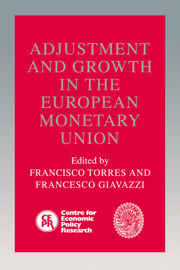Book contents
- Frontmatter
- Contents
- List of figures
- List of tables
- Preface
- List of contributors
- Foreword
- 1 Introduction
- 2 Economic and monetary union: critical notes on the Maastricht Treaty revisions
- Discussion
- 3 The design of optimal fiscal rules for Europe after 1992
- Discussion
- 4 Contracts, credibility and common knowledge: their influence on inflation convergence
- Discussion
- 5 Inflation in fixed exchange regimes: the recent Portuguese experience
- Discussion
- 6 Models of economic integration and localized growth
- Discussion
- 7 Shocking aspects of European monetary integration
- Discussion
- 8 Lessons of Massachusetts for EMU
- Discussion
- 9 Financial and currency integration in the European monetary system: the statistical record
- Discussion
- 10 Currency substitution: from the policy questions to the theory and back
- Discussion
- 11 Coordination of capital income taxes in the economic and monetary union: what needs to be done?
- Discussion
- Index
Discussion
Published online by Cambridge University Press: 29 January 2010
- Frontmatter
- Contents
- List of figures
- List of tables
- Preface
- List of contributors
- Foreword
- 1 Introduction
- 2 Economic and monetary union: critical notes on the Maastricht Treaty revisions
- Discussion
- 3 The design of optimal fiscal rules for Europe after 1992
- Discussion
- 4 Contracts, credibility and common knowledge: their influence on inflation convergence
- Discussion
- 5 Inflation in fixed exchange regimes: the recent Portuguese experience
- Discussion
- 6 Models of economic integration and localized growth
- Discussion
- 7 Shocking aspects of European monetary integration
- Discussion
- 8 Lessons of Massachusetts for EMU
- Discussion
- 9 Financial and currency integration in the European monetary system: the statistical record
- Discussion
- 10 Currency substitution: from the policy questions to the theory and back
- Discussion
- 11 Coordination of capital income taxes in the economic and monetary union: what needs to be done?
- Discussion
- Index
Summary
Frankel, Phillips and Chinn have written a very useful chapter indeed. In a few pages they give a full documentation of the nominal convergence among the EMS economies. Their goal is very ambitious: to try to measure such an immaterial thing as credibility. Others have already tried, but the authors of this chapter have done it by measuring another immaterial thing: the expected but not materialized re-alignment of the central parities.
Of course, they can work only on clues; nonetheless the results they get are quite reasonable: the fears of realignment have declined in the very recent past, hence the credibility of the exchange rate mechanism (ERM) has increased.
This statement allows the authors to draw the following two conclusions:
(a) differentials in interest rates among the EMS countries mainly depend on the degree of currency integration, and only to a smaller extent on the integration of financial markets;
(b) as the ERM approaches full credibility, predictions of Paul Krugman's target zone model (Krugman, 1991), which seemed to have failed empirical confirmation, can be tested more consistently.
As far as point (b) is concerned, the chapter documents a statistical and econometric procedure which shows that the target zone model predictions are not rejected by actual behaviour. The general analytical design of such an empirical analysis is presented in another publication by the first two authors – Frankel and Phillips (1991) – to which the reader should refer for possible criticism.
- Type
- Chapter
- Information
- Adjustment and Growth in the European Monetary Union , pp. 311 - 317Publisher: Cambridge University PressPrint publication year: 1993



